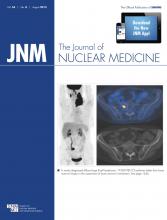TO THE EDITOR: We read with great interest the recent article by Cheung et al. on the utility of 11C-acetate/18F-FDG PET/CT for clinical staging and appropriate selection of patients with hepatocellular carcinoma (HCC) for liver transplantation based on the Milan criteria (1). The authors of this study were able to show the strength of PET/CT over dynamic contrast-enhanced CT to detect HCCs (particularly small ones measuring 1–2 cm) and to differentiate between benign and malignant hepatic lesions in the cirrhotic liver (1). However, Cheung et al. (1) were unable to show a complementary role for both tracers (i.e., 11C-acetate and 18F-FDG) in HCC. Apparently, the sensitivity of 11C-acetate PET alone for TNM staging and selection of patients for liver transplantation based on the Milan criteria did not change after 18F-FDG PET was added to the diagnostic algorithm (1). However, we believe the capabilities of 18F-FDG PET were not fully exploited in this study. In this communication, we would like to emphasize the unrecognized value of 18F-FDG PET for the evaluation of HCC and share our view on the promise of 18F-FDG PET/MR imaging in this setting.
First, 18F-FDG PET allows not only for tumor detection but also for characterization of cancer biology; that is, aggressive cancers tend to have higher levels of 18F-FDG uptake whereas less aggressive cancers tend to have lower levels of 18F-FDG uptake (2). This dimension of diagnostic information provided by 18F-FDG PET is important because it can be used to improve determination of disease prognosis and treatment planning (2). A study published in JNM in 1995 already showed that 18F-FDG uptake in HCC correlates with hexokinase/glucose-6-phosphatase activity and differentiation grade (3). These observations have been confirmed by a more recent study published in JNM in 2008 reporting that well-differentiated HCCs have a lower mean 18F-FDG maximum standardized uptake value (SUVmax) than poorly differentiated HCCs (5.10 vs. 7.66), in contrast to nonsignificant differences in 11C-acetate SUVmax (5.27 vs. 4.94). In addition, patients with 18F-FDG–positive lesions were reported to have a significantly shorter survival than patients with 18F-FDG–negative lesions (P < 0.05) (4). In the study by Cheung et al. (1), 18F-FDG PET was used only for tumor detection rather than tumor detection and characterization. It would be of great interest to incorporate the 18F-FDG PET information on HCC biology into a predictive model (to select patients for liver-directed interventions) that goes beyond the structural imaging–based Milan criteria (5).
Second, it is important to realize that the absolute accumulation of 18F-FDG in a cell is a dynamic process, with 18F-FDG release from the cell depending on the ratio of hexokinase to glucose-6-phosphatase. The dynamics of 18F-FDG accumulation in HCCs, benign liver lesions, and background tissue go beyond 60 min after 18F-FDG administration (the conventional time point at which 18F-FDG PET is routinely performed, as was also done in the study by Cheung et al. (1)) (6–8). Additional PET imaging at a later time point (i.e., dual-time-point or delayed imaging) may be advantageous because 18F-FDG accumulation in benign liver lesions and background tissue may decrease (7,8) whereas 18F-FDG accumulation in HCCs may further increase (6). This, in turn, may improve the detection of both HCCs and metastases. Dual-time-point 18F-FDG PET may also provide additional prognostic information, because more aggressive cancers tend to exhibit increasing 18F-FDG levels over time, in contrast to less aggressive ones (8,9). For example, in a study published in JNM in 2010, it was reported that lung adenocarcinoma patients with an increase in 18F-FDG SUVmax of at least 25% between 1 and 1.5 h after injection had a median survival of 15 mo, compared with 39 mo for those with less than a 25% 18F-FDG SUVmax increase (P < 0.001) (9). Certainly, more work needs to be done to prove the value of dual-time-point 18F-FDG PET in HCC, but given the potential of this technique (7–9), it would be inappropriate to disregard its value in HCC at this moment.
Third, Cheung et al. (1) compared 11C-acetate/18F-FDG PET with dynamic contrast-enhanced CT. However, dynamic contrast-enhanced CT has been shown to be inferior to dynamic contrast-enhanced MR imaging with hepatobiliary contrast agents in the cirrhotic liver, especially for the detection of lesions measuring 1–2 cm (10). The sensitivity of MR imaging in this setting was 85%, versus 65% for CT (P < 0.01), whereas specificity (94% and 89%, respectively) was comparable. We envision an important role for combined 18F-FDG PET/MR imaging for the evaluation of patients with HCC, given the utility of dynamic contrast-enhanced MR imaging with hepatobiliary contrast agents for HCC detection (this technique is already used on a routine clinical basis), the aforementioned unexploited new dimensions of 18F-FDG PET, and the rise of integrated PET/MR imaging systems. Although the number of clinical PET/MR imaging systems is currently still limited, this technique is rapidly spreading. Thus, it can be expected that the availability of PET/MR imaging to HCC patients will soon increase. At that time, 18F-FDG PET/MR imaging may well prove to be a more clinically feasible method than a diagnostic approach that uses 11C-acetate PET, requiring an on-site cyclotron.
In conclusion, we believe that 18F-FDG PET has an important role in the evaluation of HCC, if the information provided in an 18F-FDG PET scan is correctly interpreted (18F-FDG uptake reflects HCC biology and should not be used merely for cancer detection) and the technique is optimized (dual-time-point imaging has the potential to improve detection of both primary and metastatic HCC and can provide additional prognostic information). Finally, given the fact that advanced but clinically mature MR imaging techniques are superior to CT for HCC detection, we foresee an important role for 18F-FDG PET/MR imaging for the evaluation of HCC patients.
Footnotes
Published online Jun. 18, 2013.
- © 2013 by the Society of Nuclear Medicine and Molecular Imaging, Inc.







